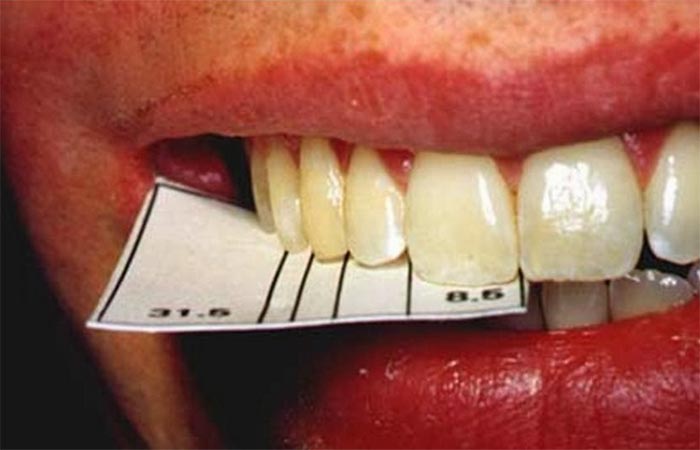


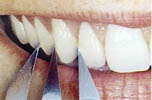
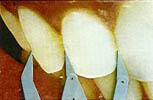
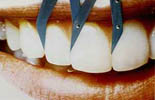
The first Golden Proportion relationship, and the most important to be discovered, is a simple tooth to tooth Golden Proportion as shown above This shows the Golden Mean Gauge superimposed on a photograph of teeth showing that the width of the central incisor is in the Golden Proportion to the width of the lateral incisor. Similarly, the Gauge shows the lateral incisor is in the same Golden Proportion to the canine in the adjacent photo and the canine is in the Golden Proportion to the first premolar.
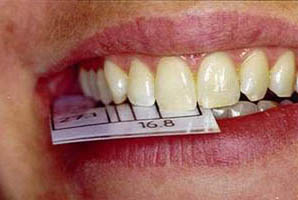 The four front teeth, from central incisor to premolar are the most significant part of the smile and they are in the Golden Proportion to each other. This phenomenon has been combined in a grid which can be used to assist us in perfecting the aesthetics of the eight front teeth. The adjacent diagram shows such a grid in the mouth with the front teeth clearly shown in the demarcations predicted.
The four front teeth, from central incisor to premolar are the most significant part of the smile and they are in the Golden Proportion to each other. This phenomenon has been combined in a grid which can be used to assist us in perfecting the aesthetics of the eight front teeth. The adjacent diagram shows such a grid in the mouth with the front teeth clearly shown in the demarcations predicted.
Note also that the grid lines up with the corner of the mouth (i.e. the end of the smile) and the dominant corner of the arch, predicting both positions.
The widths of the spaces for the teeth are all in the Golden Proportion to each other.

The number in the solid circle refers to the width of the central incisor. There are 7 grids to accept all widths of central incisor from 7 to 10 mms in steps of 1/2 mms.The grid also shows a number in a dotted circle which refers to the width of the smile.
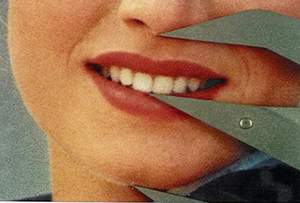
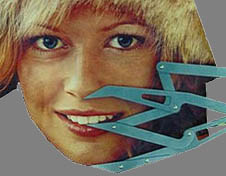
In the relaxed face, where the teeth are not touching together (when the lower jaw is in the rest position with free way space present) the lip line divides the lower third of the face into the Golden Proportion. The space between the bottom of the nose and the bottom of the chin is divided by the lip line into a “chin to lip line” (the larger part) and a smaller part the “lip line to under the nose” The smaller to the larger is in the Golden Proportion as illustrated above. These photographs show how the Golden Mean Gauge could be used in prosthetics to assist in determining the height of the incisors. If used in conjunction with phonetics and disclusion, there should be no “incisal edge” position problems. Incidentally, you may notice that some photographs of people smiling look something more like a grimace or a snarl. Why ? Because the teeth are clenched together rather than teeth apart, with freeway space between the jaws. This is also commonly called a grin rather than a smile. Smile, grin, snarl is the order.
Pictures of any pleasant smile would show that the teeth do not extend right to the corners of the mouth but actually stop some distance from them. Thus there is an area of neutrality or darkness between the teeth and the corner of the smiling mouth. Between these two neutral spaces lies the anterior aesthetic segment. The neutral space lies between the dental arch and corner of the smiling mouth. It is a dynamic space which appears in a broad smile, constantly changing with different expressions. It can be defined as a bilateral space bounded laterally by the corner of the smiling mouth and medially by the arch. In the aesthetically pleasing smile the spaces between the corner of the mouth and the dental arch form a backdrop in which the anterior aesthetic segment is featured. The anterior aesthetic segment is in the Golden Proportion to the width as illustrated in the following paragraphs.
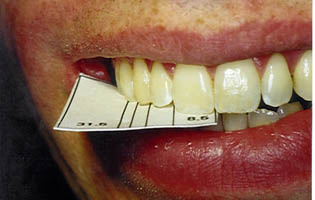
Notice that in the photograph of the grid in the mouth, the edge of the grid lines up with the corner of the smile. This is another compound Golden Proportion showing that the width of ALL the 8 front teeth together are in the Golden Proportion to the width of the smiling lips. The anterior aesthetic segment, from 1st premolar to 1st premolar, is highlighted against the backdrop of the smiling lips, with two neutral parts laterally between lips and teeth. The white of the 8 front teeth is in the Golden Proportion to the width of the smile.
The most primitive ancient drawings of the face is also representative of the earliest drawings of children. Two dashes for eyes and a curve for the smiling mouth surrounded by a circle for the face as above in fig i, ii, iii, iv). Psychiatrists have confirmed the importance of the mother’s smile and its effect upon a very young child.

This child’s drawing has some fascinating features, which are of relevance to dental aesthetics. It indicates the important aesthetic landmarks which are represented by the ends of these apparently casual dashes. (The dash representing the eye is terminated laterally by the outer canthus of the eye. Medially it is the lateral aspect of the inner canthus or the end of the visible white eyeball.)
The distance between the two eyes is the distance between the ‘EYE WHITES’.

They are beautifully interrelated in the Golden Proportion as shown in the photo of eyes above. This can be seen as a diagram in figure iii, where AB:BC in the Golden Proportion.
In the drawings of older children the eye-dashes become circles and the lips are apart (Fig iii).


We are thus presented with a new group of fascinating Golden Proportions that are helpful in prosthodontics. Note that the lips apart drawn in figure iii do not extend right to the corner of the mouth they actually stop some distance from them. Thus there is an area of darkness or neutrality between the teeth and the corner of the smiling mouth which is one of the most important factors in giving prosthesis a natural appearance.
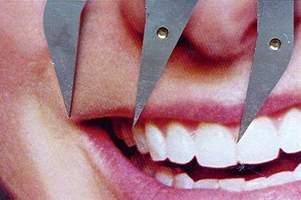
This again is shown in photo where the gauge, with one point on the midline, the other on the width of the smile shows the middle point on the buccal surface of first premolar. The Golden Mean Gauge shows that the corner of the arch divides the smile into a larger tooth part and a smaller neutral space and gives us another guide as to how to arrange the visual effect of this important corner. The same phenomenon is also illustrated in the figure below where the edge of the Grid lines up with the edge of the smile and the 4 teeth end at this position.
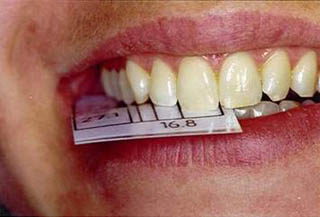
In the aesthetically pleasing smile the spaces between the corners of the mouth and the dental arch form a backdrop in which the anterior aesthetic segment is featured. This is a frequent variation of the Golden Proportion which can be seen in more detail the bilateral form.
The WHITE of the eyes AB is in the Golden Proportion to the space between the eyes BC as seen in the children’s photo of eyes fig(iv) below.

From this we can conclude that the WHITE width FG of the Anterior Aesthetic Segment is in the Golden Proportion to the WHITE of the eyes AB, as follows:
By measurement it will be found that the width of the smiling lips from one corner of the mouth to the other is equal to the distance between the bridge of the nose plus the width of the eye, AC=DE (fig iv).
|
Smaller |
.618 |
Eyes |
AB |
Bridge |
BC |
Larger |
||||||
|
——– |
= |
—- |
= |
—— | = |
— |
= |
———— |
= |
— |
= |
——- |
|
Larger |
1 |
Bridge |
BC |
Eye+ Bridge |
AC |
Whole |
|
FG |
teeth in Smile |
Larger |
||
|
— |
= |
————— |
= |
——- |
|
DE |
width of Smile |
Whole |
BC Bridge = FG Teeth showing in Smile.
AC Eye + Brdge = DE Width of Smile.
|
BC – Bridge – Larger |
FG – Teeth in Smile – Larger |
|
|
—————————- |
= |
—————————– |
|
AC- Eyes+Bridge – Whole |
DE – Whole Smile – Whole |
BC (Bridge) = FC (Teeth in Smile)
and AC (Eyes + Bridge) = DE (Width of Smile)
REFERENCES
The application of the Golden Proportion to dental aesthetics was first written about by the author in 1978. Those humble beginnings have sown the seeds of a proliferation of Golden Proportion studies undertaken in three main directions, prosthodontic, surgical and orthodontic.
Winston Senior, an eminent orthodontist in Manchester, UK, was the first orthodontist to appreciate the application of the Golden Proportion to orthodontics. It is with thanks to his enthusiastic lectures and case reports that so many orthodontists have taken a strong interest in the application of the Golden Proportion. In his most recent article he shows how ideal dental /facial aesthetics can be planned by combining the Golden Proportion with cephalometric analysis, plastic surgery and dental restorations. In the same article he shows a Golden Proportion relationship of the width between the buccal surfaces of the two upper canines to the width between the disto buccal corners of the upper first molars as in fig. INSERT FIG 9 senior
Ricketts 1982 showed numerous cephalometric tracings of orthodontic landmarks in the Golden Proportion. He also showed amazing growth patterns in the Golden Proportion which radiated from fixed cephalometric points.
Dr McArthur 1985 wrote an article “Maxillary and Mandibular Teeth Widths” in which he explains that the average ratio of upper central incisor to lower central incisor is 1.62. The author’s response to this observation, published in the Journal of Prosthetic Dentistry was to thank Dr Mcarthur for another good example of the Golden Proportion.
Shoemaker in 1987 wrote a series of articles promoting the use of the Golden Proportion as an adjunct to cosmetic Dentistry.
Amoric 1989 in his article “Le nombre d’or” showed many Golden Proportions in cephalometric tracings at various stages of facial growth and also included geometrical propositions.
The Annals of Plastic Surgery 1989 include a fascinating study by Kawakami et al who investigated the Golden Proportion balance between eyes, nose and mouth in the facial appearance of typical Japanese individuals and, comparing the ratios to Caucasians, each ratio was then used for pre and post-operative aesthetic analysis using Moire’ topography.
Dr Jack Preston 1993, although initially critical of the application of the Golden Proportion,. has since been influenced by the studies of Stephen Marquardt, and is now in total support of the concept *Dr. Preston Jack. Personal communication, 1998. Marquardt developed a Golden Proportion Pentagon Grid for Facial plastic surgery. Preston nevertheless showed a very close Golden Proportion relationship between the lower lateral incisor and the upper central incisor in his article, above.
Dr Yosh Jefferson 1996 illustrates an article in the Journal of General Orthodontics with many Golden Proportion diagrams and computer generated photographs giving an ideal picture of the whole head. His work is also supported with cephalometric tracings.
In contrast Gillen 1994 measured the widths of the incisors and stated that there was no Golden Proportion correlation. In his article he clearly states that his measurements were of “the entire widths of the incisors”, and acknowledges that the Golden Proportion phenomenon applies only to the widths as “seen”. This is such a common misconception that it is worth repeating that the Golden Proportion phenomenon applies to the widths of teeth as seen from the front and not the actual widths as measured.
The author’s work on the Golden Proportion is now compulsory study in many dental schools.
This principle of proportion has been known since the time of the Ancient Greeks, and has been rediscovered, described and studied by many famous people who applied it in their own fields. Artists, Borissavlievitch 1958; Leonardo 1490; Dürer, 1528; Ghyka 1964; mathematicians, Huntley 1970; Gardner, 1966; architects, Corbusier, 1961; musicians, Lendvai, 1971; scientists, Thompson, 1952; Coxeter, 1961 Gyorgi Doczi , Hambridge 1921; philosophers, Koestler, 1962; psychologists, Benyafield & Adams, 1976.. In the same way the author rediscovered the Golden Proportion and brought it to the attention of the dental world in 1978. Space only allows for the briefest reference to a few of the rediscoveries.
Huntley, a modern mathematician, wrote an informative book called The Divine Proportion, the whole of which was devoted to the study of the Golden Proportion. The cover features a Golden Proportion spiral built on a triangle.
La Corbusier, the highly acclaimed Parisian architect, developed a scale for architecture, the “modular”, which is based on the golden sections of the human body. His famous buildings were all based on the Golden Proportion. His book “La Modular” has been reprinted numerous times.
It was known that Bela Bartok (1881-1945) used secret methods in his musical compositions. In a book written and researched by Lendavi it was revealed that he used the principles of the Golden Proportion extensively in his compositions.
In its simplest form we can recognise the Golden Proportion as the division of a straight line into a larger and a smaller part with the Golden Proportion gauge as in the figure below:

In a Golden Proportion rectangle however the smaller part is at right angles to the larger part as shown below:
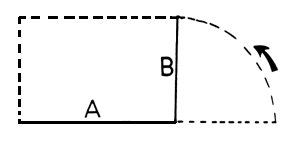
A frequent example of this is the ubiquitous plastic credit and telephone card all golden proportion rectangles.

We dentists find the proportions of the central incisor very beautiful, but we have not been able to find a Golden Proportion relationship between the obvious width and height. The problem was recently solved when Dr Stephen Marquardt, an eminent Oral surgeon in California, discovered that, “The HEIGHT of the central incisor is in the Golden Proportion to the WIDTH of the TWO central incisors.” as below:
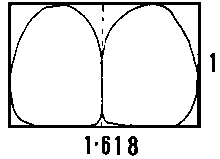
The rectangle is determined by using the Golden Proportion gauge to measure the width of the two incisors and then to use the gauge to check the height, (there will soon be a grid available to do this easily, or the dimensions can be measured). This revelation has offered solutions to a host of dental aesthetic problems.
The Golden Proportion shows us a way of confirming the widths of the incisors by measuring their heights. It is a formula for evaluating the horizontal against the vertical. Testing the phenomenon on photographs of attractive teeth shows a very close compliance between the theoretical and the practical. The gingival prostheses of Fig A, before and Fig B after, not only covers the unsightly exposed roots but also brings the gingival level down to establish a Golden Rectangle on the central incisors. With thanks to Detax for use of their photograph below, showing GINGAVAMOL artificial gingiva.
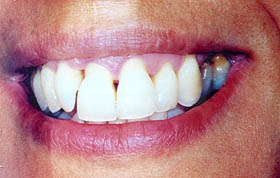
Fig A Before
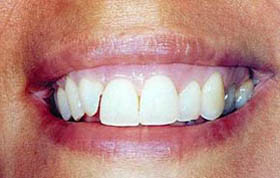
Fig B After
It is very helpful to use the gauge to check the rectangle and then confirm with the grids. If both methods give the same indication you can be certain that the aesthetic result will be very satisfactory. The Golden Proportion grids show the inter-tooth relationship between the 8 teeth of the anterior aesthetic segment whereas the rectangle confirms the width of the incisors, related to their height. In the situation where it is necessary to close gaps between teeth with crowns, the combination of grid and rectangle will mutually confirm the aesthetic solution with a certainty that it will look attractive and natural. These grids are complementary to the Golden Proportion rectangle. The combination of the two gives a powerful tool to confidently determine good aesthetics.
| LIST OF REFERENCES as above. ALPHABETICAL |
K Alburn, JM Smith, S Steel, D Walker (1973). The Language of Pattern. Thames & Hudson, London.Benyafield and Adams (1976). The Golden Section Hypothesis. Brit J Psychol 67: 11-15.M Borissavlievitch (1958). The Golden Number. Alec Tiranti, London.Le Corbusier (1961). The Modulor. Faber and Faber, London.HSM Coxeter (1961). Introduction to Geometry. John Wiley & Sons Ltd, London.A Dürer (1528). Vier Bucher von menschlicher Proportion.M Ghyka (1964). Goemetrical Composition and Design. Alec Tiranti, London.M Gardner (1966). More Mathematical Puzzles and Diversions. Penguin Books, London.J Hambidge (1921). Dynamic symmetry. Scientific American 4:23.HE Huntley (1970). The Divine Proportion. Dover Publications, New York.A Koestler (1962). The Perfect Solids in The Watershed, Heinemann.R Lawlor (1982). Sacred Geometry Philosophy and Practice. Thames and Hudson Ltd, London.E Lendvai (1971). Béla Bartók An Analysis of his Music. Kahn & Averill, London.LeonardoE Levin (1978). Dental esthetics and the Golden Proportion. J Prosthet Dent 40(3):244-252.L Paccioli (1896). Divina Proportione. C Winterberg, Wien Graser.RM Ricketts (1981). The Golden Divider. J Clin Orthodon vol XV, No 11:752-759.DW Thompson (1952). Growth and Form. Cambridge University Press, Oxford.
Hi, under The Diagnostic Grid, I can not understand the number 38,8 in relation to the other numbers. Can you explain for me?
Best regards Lars Söjholm
The total length of the 4 front teeth is 8.5 * (1 + 0.618 + 0.618^2 + 0.618^3)=19.0056, which is in Golden proportion to the half width of the smile (30.8 * 0.618 = 19.0344).